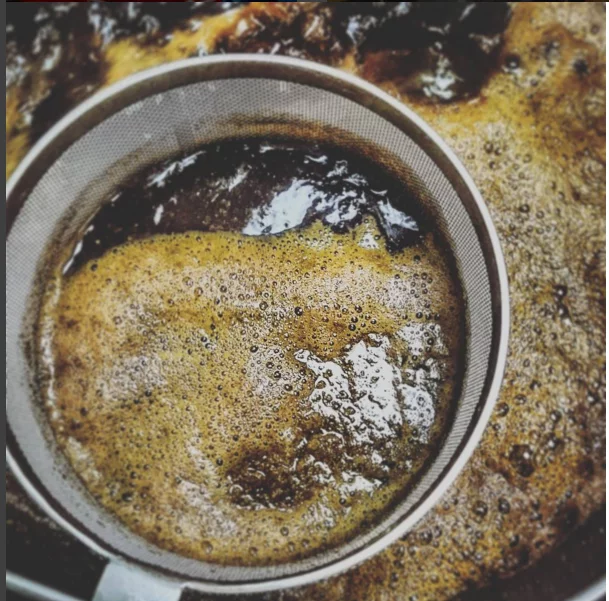The ‘received wisdom’ in the homebrew world is that using a bag to add your hops in will reduce hop utilisation by around 10% meaning, if you calculate your hop contributions without taking this into consideration your bitterness is going to be around 10% lower than it should be which will negatively affect the balance of your beer.
The idea behind this is that bags or hop spiders limit the hops’ contact area with the boiling wort and therefore have a negative impact on how much isomerised acids are dissolved into the wort.
So how do you compensate for this? Well, let’s take a look at how hop utilisation is calculated.
Firstly we have to calculate the alpha acid units (AAU) using the calculation;
AAU = Weight x % Alpha Acids (whole number)
This means, if I’m using 20 g of Simcoe (13% AA) at the start of a 60 minute boil I can calculate the AAUs by converting grams to ounces (weight in grams multiplied by 0.035) and doing the following calculation;
AAU = 0.7 x 13 = 9.1 AAU
This number alone however is not much use to us (unless we are trying to match the AAU of an already created recipe) as factors such as the recipe volume, the boil gravity and the amount of time that you boil for must all be factored in when calculating bitterness contribution. This can be done fairly simply if we add these factors into our calculation – where weight of hops in grams is W, recipe volume is V, time and gravity of boil (called utilisation) is expressed as U and alpha acid percentage is %A. The calculation then looks like this;
IBU = W x %A x U x 10 / V
In the above equation, multiplying by 10 is how we convert the outcome to grams and litres – if you don’t use grams and litres this factor should be 75.
To work out the gravity of your boil you need to know the yield of your malts in points per pound per gallon. (For anyone not using pounds, 1 lb = 0.45 kg and 1 US Gal = 3.78 L).
If you’re brewing a recipe containing 5 kg (11 lb) of Maris Otter and you know that 1 lb per US Gal should give you a gravity of 1.038 at 100% extract potential (http://www.homebrewtalk.com/wiki/index.php/Malts_Chart) then you can calculate your OG using the formula;
OG = malt weight in lb X by your yield in points per pound per gallon / by your batch size
Which would give you;
OG = 11 x 38 / 5 = 83.6 or 1.084
And you can use the table at the bottom of this article to work out your utilisation based on the gravity of your boil.
So if we are using 20g of cascade (7%AA) at 60 minutes in a 23 L batch we get;
IBU = 20 x 7 x 0.170 x 10 / 23
So our IBUs = 10.35
Or, more usefully we can decide how many IBUs we want (say 20) and work out a weight of hops required to get this IBU by rearranging the formula;
W = V x IBU / %A x U x 10
W = 23 x 20 / 7 x 0.170 x 10
W = 460 / 11.9
W = 38.7 grams
So we know for 20 IBUs we need to add 38.7 g of cascade.
Knowing this means we can factor in the extra 10% we need to counteract the drop in utilisation when using a hop bag or spider.
Boil Original Gravity Time 1.030 1.040 1.050 1.060 1.070 1.080 1.090 1.100 1.110 1.120 1.130 (min) 0 0.000 0.000 0.000 0.000 0.000 0.000 0.000 0.000 0.000 0.000 0.000 3 0.034 0.031 0.029 0.026 0.024 0.022 0.020 0.018 0.017 0.015 0.014 6 0.065 0.059 0.054 0.049 0.045 0.041 0.038 0.035 0.032 0.029 0.026 9 0.092 0.084 0.077 0.070 0.064 0.059 0.054 0.049 0.045 0.041 0.037 12 0.116 0.106 0.097 0.088 0.081 0.074 0.068 0.062 0.056 0.052 0.047 15 0.137 0.125 0.114 0.105 0.096 0.087 0.080 0.073 0.067 0.061 0.056 18 0.156 0.142 0.130 0.119 0.109 0.099 0.091 0.083 0.076 0.069 0.063 21 0.173 0.158 0.144 0.132 0.120 0.110 0.101 0.092 0.084 0.077 0.070 24 0.187 0.171 0.157 0.143 0.131 0.120 0.109 0.100 0.091 0.083 0.076 27 0.201 0.183 0.168 0.153 0.140 0.128 0.117 0.107 0.098 0.089 0.082 30 0.212 0.194 0.177 0.162 0.148 0.135 0.124 0.113 0.103 0.094 0.086 33 0.223 0.203 0.186 0.170 0.155 0.142 0.130 0.119 0.108 0.099 0.091 36 0.232 0.212 0.194 0.177 0.162 0.148 0.135 0.124 0.113 0.103 0.094 39 0.240 0.219 0.200 0.183 0.167 0.153 0.140 0.128 0.117 0.107 0.098 42 0.247 0.226 0.206 0.189 0.172 0.158 0.144 0.132 0.120 0.110 0.101 45 0.253 0.232 0.212 0.194 0.177 0.162 0.148 0.135 0.123 0.113 0.103 48 0.259 0.237 0.216 0.198 0.181 0.165 0.151 0.138 0.126 0.115 0.105 51 0.264 0.241 0.221 0.202 0.184 0.169 0.154 0.141 0.129 0.118 0.108 54 0.269 0.246 0.224 0.205 0.188 0.171 0.157 0.143 0.131 0.120 0.109 57 0.273 0.249 0.228 0.208 0.190 0.174 0.159 0.145 0.133 0.121 0.111 60 0.276 0.252 0.231 0.211 0.193 0.176 0.161 0.147 0.135 0.123 0.112 70 0.285 0.261 0.238 0.218 0.199 0.182 0.166 0.152 0.139 0.127 0.116 80 0.291 0.266 0.243 0.222 0.203 0.186 0.170 0.155 0.142 0.130 0.119 90 0.295 0.270 0.247 0.226 0.206 0.188 0.172 0.157 0.144 0.132 0.120 120 0.301 0.275 0.252 0.230 0.210 0.192 0.176 0.161 0.147 0.134 0.123
Table from http://www.realbeer.com/hops/research.html
What’s different about the Mangrove Jack’s Hop Spider is that although the mesh is fine enough to stop most hop debris from getting into the boil in the first place, it is also large enough to allow full contact with the wort meaning it is unlikely you will see any significant drop in utilisation.

